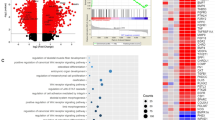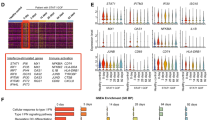Abstract
Mutations in the coiled-coil and DNA-binding domains of STAT1 lead to delayed STAT1 dephosphorylation and subsequently gain-of-function. The associated clinical phenotype is broad and can include chronic mucocutaneous candidiasis (CMC) and/or combined immunodeficiency (CID). We report a case of CMC/CID in a 10-year-old boy due to a novel mutation in the small ubiquitin molecule (SUMO) consensus site at the C-terminal region of STAT1 leading to gain-of-function by impaired sumoylation. Immunodysregulatory features of disease improved after Janus kinase inhibitor (jakinib) treatment. Functional testing after treatment confirmed reversal of the STAT1 hyper-phosphorylation and downstream transcriptional activity. IL-17 and IL-22 production was, however, not restored with jakinib therapy (ruxolitinib), and the patient remained susceptible to opportunistic infection. In conclusion, a mutation in the SUMO consensus site of STAT1 can lead to gain-of-function that is reversible with jakinib treatment. However, full immunocompetence was not restored, suggesting that this treatment strategy might serve well as a bridge to definitive therapy such as hematopoietic stem cell transplant rather than a long-term treatment option.






Similar content being viewed by others
References
Liu L, Okada S, Kong XF, Kreins AY, Cypowyj S, Abhyankar A, et al. Gain-of-function human STAT1 mutations impair IL-17 immunity and underlie chronic mucocutaneous candidiasis. J Exp Med. 2011;208(8):1635–48.
van de Veerdonk FL, Plantinga TS, Hoischen A, Smeekens SP, Joosten LAB, Gilissen C, et al. STAT1 mutations in autosomal dominant chronic mucocutaneous candidiasis. N Engl J Med. 2011;365(1):54–61.
Toubiana J, Okada S, Hiller J, Oleastro M, Lagos Gomez M, Aldave Becerra JC, et al. Heterozygous STAT1 gain-of-function mutations underlie an unexpectedly broad clinical phenotype. Blood. 2016;127(25):3154–64.
Smyth AE, Kaleviste E, Snow A, Kisand K, McMahon CJ, Cant AJ, et al. Aortic calcification in a patient with a gain-of-function STAT1 mutation. J Clin Immunol. 2018;38(4):468–70.
Takezaki S, Yamada M, Kato M, Park MJ, Maruyama K, Yamazaki Y, et al. Chronic mucocutaneous candidiasis caused by a gain-of-function mutation in the STAT1 DNA-binding domain. J Immunol. 2012;189(3):1521–6.
Depner M, Fuchs S, Raabe J, Frede N, Glocker C, Doffinger R, et al. The extended clinical phenotype of 26 patients with chronic mucocutaneous candidiasis due to gain-of-function mutations in STAT1. J Clin Immunol. 2016;36:73–84.
Meesilpavikkai K, Dik WA, Schrijver B, et al. A novel heterozygous mutation in the STAT1 SH2 domain causes chronic mucocutaneous candidiasis, atypically diverse infections, autoimmunity, and impaired cytokine regulation. Front Immunol. 2017;8:274.
Al Dhanhani H, Al Shehri T, Lilic D, et al. Double trouble? CMC with a mutation in both AIRE and STAT1. J Clin Immunol. 2018;38(6):635–7.
Sobh A, Chou J, Schneider L, Geha RS, Massaad MJ. Chronic mucocutaneous candidiasis associated with an SH2 domain gain-of-function mutation that enhances STAT1 phosphorylation. J Allergy Clin Immunol. 2016;138(1):297–9.
Sampaio EP, Ding L, Rose SR, Cruz P, Hsu AP, Kashyap A, et al. Novel signal transducer and activator of transcription 1 mutation disrupts small ubiquitin-related modifier conjugation causing gain of function. J Allergy Clin Immunol. 2018;141(5):1844–1853 e1842.
Weinacht KG, Charbonnier LM, Alroqi F, Plant A, Qiao Q, Wu H, et al. Ruxolitinib reverses dysregulated T helper cell responses and controls autoimmunity caused by a novel signal transducer and activator of transcription 1 (STAT1) gain-of-function mutation. J Allergy Clin Immunol. 2017;139(5):1629–1640 e1622.
Zheng J, van de Veerdonk FL, Crossland KL, Smeekens SP, Chan CM, al Shehri T, et al. Gain-of-function STAT1 mutations impair STAT3 activity in patients with chronic mucocutaneous candidiasis (CMC). Eur J Immunol. 2015;45(10):2834–46.
Ungureanu D, Vanhatupa S, Kotaja N, et al. PIAS proteins promote SUMO-1 conjugation to STAT1. Blood. 2003;102(9):3311–3.
Ungureanu D, Vanhatupa S, Gronholm J, et al. SUMO-1 conjugation selectively modulates STAT1-mediated gene responses. Blood. 2005;106(1):224–6.
Begitt A, Droescher M, Knobeloch KP, Vinkemeier U. SUMO conjugation of STAT1 protects cells from hyperresponsiveness to IFNgamma. Blood. 2011;118(4):1002–7.
Higgins E, Al Shehri T, McAleer MA, et al. Use of ruxolitinib to successfully treat chronic mucocutaneous candidiasis caused by gain-of-function signal transducer and activator of transcription 1 (STAT1) mutation. J Allergy Clin Immunol. 2015;135(2):551–3.
Forbes LR, Vogel TP, Cooper MA, Castro-Wagner J, Schussler E, Weinacht KG, et al. Jakinibs for the treatment of immune dysregulation in patients with gain-of-function signal transducer and activator of transcription 1 (STAT1) or STAT3 mutations. J Allergy Clin Immunol. 2018;142(5):1665–9.
Gronholm J, Vanhatupa S, Ungureanu D, et al. Structure-function analysis indicates that sumoylation modulates DNA-binding activity of STAT1. BMC Biochem. 2012;13:20.
Sampaio EP, Hsu AP, Pechacek J, Bax HI, Dias DL, Paulson ML, et al. Signal transducer and activator of transcription 1 (STAT1) gain-of-function mutations and disseminated coccidioidomycosis and histoplasmosis. J Allergy Clin Immunol. 2013;131(6):1624–34.
Uzel G, Sampaio EP, Lawrence MG, Hsu AP, Hackett M, Dorsey MJ, et al. Dominant gain-of-function STAT1 mutations in FOXP3 wild-type immune dysregulation-polyendocrinopathy-enteropathy-X-linked-like syndrome. J Allergy Clin Immunol. 2013;131(6):1611–23.
Mizoguchi Y, Tsumura M, Okada S, Hirata O, Minegishi S, Imai K, et al. Simple diagnosis of STAT1 gain-of-function alleles in patients with chronic mucocutaneous candidiasis. J Leukoc Biol. 2014;95(4):667–76.
Bernasconi AR, Yancoski J, Villa M, Oleastro MM, Galicchio M, Rossi JG. Increased STAT1 amounts correlate with the phospho-STAT1 level in STAT1 gain-of-function defects. J Clin Immunol. 2018;38(7):745–7.
Zimmerman O, Olbrich P, Freeman AF, Rosen LB, Uzel G, Zerbe CS, et al. STAT1 gain-of-function mutations cause high total STAT1 levels with normal dephosphorylation. Front Immunol. 2019;10:1433.
Zimmerman O, Rosler B, Zerbe CS, et al. Risks of ruxolitinib in STAT1 gain-of-function-associated severe fungal disease. Open Forum Infect Dis. 2017;4(4):ofx202.
Bloomfield M, Kanderova V, Parackova Z, et al. Utility of ruxolitinib in a child with chronic mucocutaneous candidiasis caused by a novel STAT1 gain-of-function mutation. J Clin Immunol. 2018;38:589–601.
Mogensen TH. IRF and STAT transcription factors - from basic biology to roles in infection, protective immunity, and primary immunodeficiencies. Front Immunol. 2019;9:3047.
Siegel AM, Heimall J, Freeman AF, Hsu AP, Brittain E, Brenchley JM, et al. A critical role for STAT3 transcription factor signaling in the development and maintenance of human T cell memory. Immunity. 2011;35(5):806–18.
Virtanen AT, Haikarainen T, Raivola J, et al. Selective JAKinibs: prospects in inflammatory and autoimmune diseases. BioDrugs. 2019;33(1):15–32.
Serhal L, Edwards CJ. Upadacitinib for the treatment of rheumatoid arthritis. Expert Rev Clin Immunol. 2018:1–13.
Al Shehri T, Abinun M, Gennery AR, et al. Is gain-of-function STAT1 CMC an interferonopathy? Clin Exp Immunol. 2015;182(S1):15.
Kaleviste E, Saare M, Leahy TR, Bondet V, Duffy D, Mogensen TH, et al. Interferon signature in patients with STAT1 gain-of-function mutation is epigenetically determined. Eur J Immunol. 2019;49(5):790–800.
van de Veerdonk FL, Netea MG. Treatment options for chronic mucocutaneous candidiasis. J Inf Secur 2016:72 Suppl:S56–S60.
Acknowledgments
The authors wish to acknowledge the good will of the patient and his parents for consenting to publication of this case report.
Funding
Authors DL and TAS were funded to undertake this research through a Medical Research Council Confidence in Concept Grant (Grant No. BH152850). Author TAS was funded by King Faisal Specialist Hospital & Research Centre grant, Saudi Arabia. Author FG was funded by Deutsche Forschungsgemeinschaft (GO2955/1-1 (F.G.)).
Author information
Authors and Affiliations
Contributions
TAS, ADR, DL: functional immunology laboratory experiments, manuscript preparation, and review.
SL, SB: NGS panel and Sanger sequencing of STAT1 gene, manuscript preparation, and review.
KG, AJC, MAS, TRL: manuscript preparation and review.
Corresponding author
Ethics declarations
Ethical approval was granted by the Great North Biobank (GNB), Reference No. 5458/10/H0906/22, and Newcastle Autoimmune Inflammatory Rheumatic Diseases (NAIRD) Research Biobank, Reference No. 10/H0106/30.
Conflict of Interest
The authors declare that they have no conflict of interest.
Additional information
Publisher’s Note
Springer Nature remains neutral with regard to jurisdictional claims in published maps and institutional affiliations.
Electronic supplementary material
ESM 1
(DOCX 420 kb)
Rights and permissions
About this article
Cite this article
Al Shehri, T., Gilmour, K., Gothe, F. et al. Novel Gain-of-Function Mutation in Stat1 Sumoylation Site Leads to CMC/CID Phenotype Responsive to Ruxolitinib. J Clin Immunol 39, 776–785 (2019). https://doi.org/10.1007/s10875-019-00687-4
Received:
Accepted:
Published:
Issue Date:
DOI: https://doi.org/10.1007/s10875-019-00687-4




